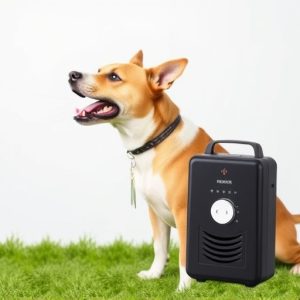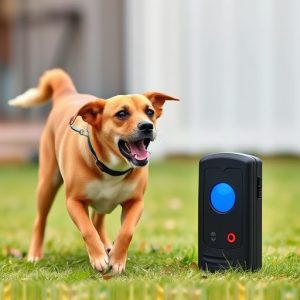Sound Wave Technology: Effective Distance & Pet Safety for Training
Sound wave technology offers a safe and effective solution for pet behavior modification, particular…….
Sound wave technology offers a safe and effective solution for pet behavior modification, particularly for issues like barking or aggression. Electronic dog deterrents use acoustic waves to target problematic behaviors up to 50 meters (164 feet) away, making them suitable for outdoor use in natural environments like parks or backyards. These devices emit inaudible ultrasonic tones and vibrations to startle dogs, with their effectiveness peaking within 10 meters. Strategic placement based on yard layout and dog activity areas is crucial for optimal results. As an Effective Distance Electronic Dog Deterrent, they provide humane, environmentally friendly, and remote control solutions for training, but responsible use is essential to prevent potential hearing damage.
“Unleashing the power of sound waves, this innovative approach to pet behavior control is gaining traction. ‘Sound Wave Pet Behavior Control’ explores the potential of advanced technology in modifying animal behavior, specifically focusing on electronic dog deterrents. From understanding the science behind it to examining its effectiveness at varying distances, we delve into the benefits and safety aspects.
Get ready to discover how this modern method could revolutionize pet training while highlighting its key advantages and considerations regarding ‘Effective Distance Electronic Dog Deterrents’.”
- Understanding Sound Wave Technology for Pet Behavior Modification
- How Effective is an Electronic Dog Deterrent at Different Distances?
- Benefits and Safety Considerations of Using Sound Waves for Pet Training
Understanding Sound Wave Technology for Pet Behavior Modification
Sound wave technology has emerged as a powerful tool for pet behavior modification, offering a safe and effective alternative to traditional methods. This innovative approach leverages acoustic waves to influence an animal’s perception and response, making it particularly useful in addressing issues like barking, aggression, or unwanted behaviors. By emitting specific sound patterns at varying frequencies, these electronic dog deterrents can target problematic behaviors without causing harm.
The effectiveness of sound wave devices is evident in their ability to operate over an impressive effective distance, allowing for outdoor use and coverage of larger areas. This feature makes them ideal for training dogs in their natural environment, such as parks or backyards, where they can learn to respond appropriately without the need for constant supervision. With consistent and targeted applications, pet owners can train their animals while maintaining a humane approach that respects their well-being.
How Effective is an Electronic Dog Deterrent at Different Distances?
The effectiveness of an electronic dog deterrent, also known as a sonic or sound wave device, varies significantly with distance. These devices emit high-frequency sounds that are generally inaudible to humans but can startle and deter dogs. At close range, usually up to 10 meters (33 feet), they prove highly effective, instantly capturing the dog’s attention and modifying its behavior. Many models use a combination of ultrasonic tones and vibration to enhance their impact within this optimal distance.
However, as you move further away from the device, its influence diminishes. Beyond 50 meters (164 feet), the sound waves may not be strong enough to reach and affect the dog, rendering the deterrent less effective. Environmental factors like wind, noise levels, and terrain can also impact the range and consistency of the signal, making it crucial for users to understand these limitations and position the devices strategically based on their yard layout and typical dog activity areas.
Benefits and Safety Considerations of Using Sound Waves for Pet Training
Sound waves, particularly in the form of electronic dog deterrents, offer a non-violent and effective method for pet behavior control. These devices emit high-frequency sound at specific ranges to correct unwanted behaviors like barking or aggression, making them ideal as an Effective Distance Electronic Dog Deterrent. The benefits are numerous; they are humane, environmentally friendly, and can be remotely controlled, allowing for discrete training sessions. Moreover, sound waves can be targeted to specific areas, minimizing disruption to neighbors and other pets.
However, safety considerations are paramount. While generally harmless, prolonged exposure to high-frequency sounds may cause discomfort or even hearing damage in some animals. It’s crucial to use these devices responsibly, following manufacturer guidelines, and ensuring proper training for both the pet and owner. Regular monitoring is essential to prevent any adverse effects and to adjust settings as needed.
The application of sound wave technology in pet behavior control shows promise, offering a humane alternative to traditional methods. As demonstrated, electronic dog deterrents can be highly effective at various distances, with optimal results within close proximity. However, safety considerations and potential side effects on pets’ hearing should prompt responsible usage. Further research is needed to explore the long-term impact of sound waves on animal behavior and well-being, ensuring this innovative approach enhances pet training while minimizing any adverse effects.


